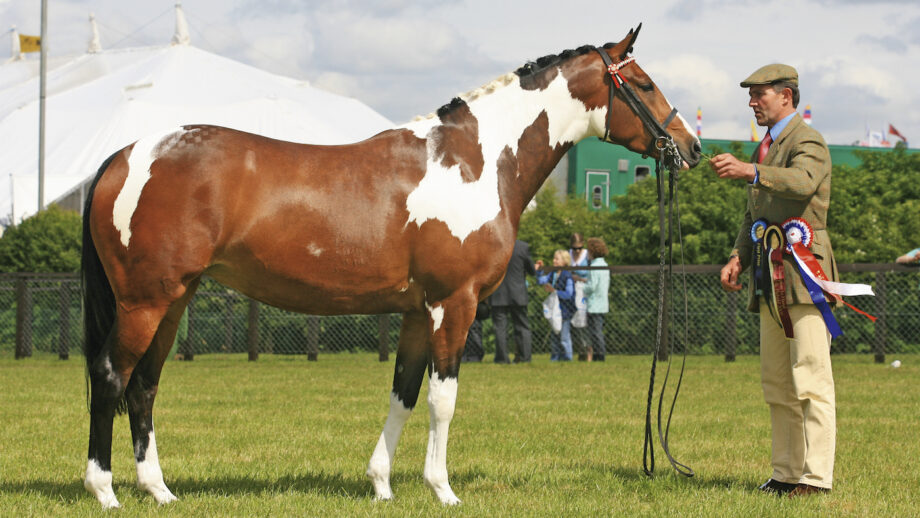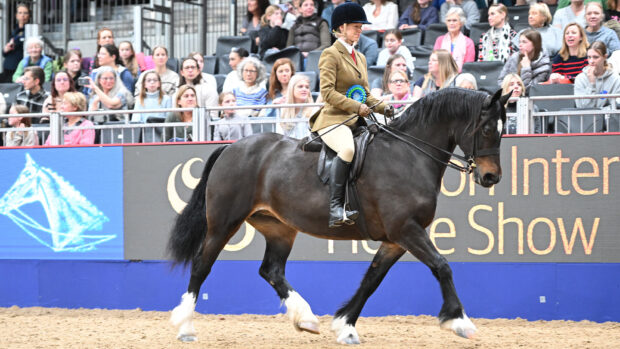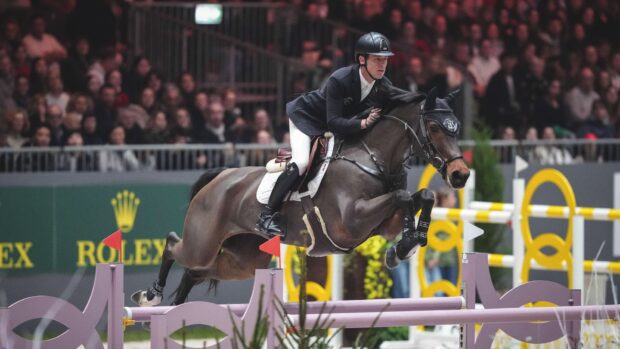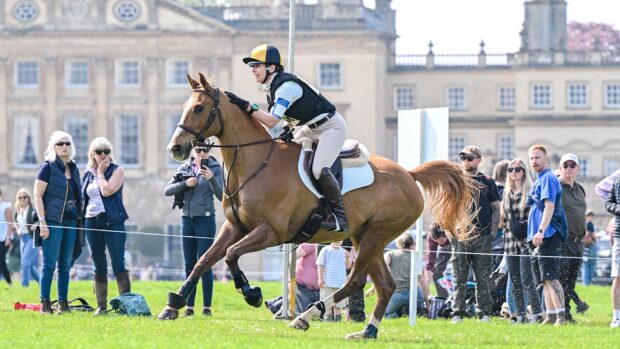Preparing mares and foals for the show ring can be one of the most rewarding experiences for a breeder.
The judging process typically involves the mare and foal being judged separately, but the pairing of dam and youngster is also taken into consideration by the judges.
To show a mare and foal, both animals should have been trained correctly to walk, trot and stand in the ring on the go-round, in the line-up and in front of the judge. Alongside this, both horses will need to cope with the busy atmosphere of a show, and be confident to load, travel and stand on the horsebox.
There’s a lot to consider when showing a mare and foal, but if the right preparation is done the rewards can be plentiful. These top tips from two of the circuit’s most established breeders are sure to help you if you’re considering prepping your own combination for the ring this term.
Who are our experts?
Jerome Harforth is one of the showing world’s most respected and knowledgeable producers. He also founded the renowned Stanley Grange Stud. Jerome has produced countless Horse of the Year Show (HOYS) and Royal International (RIHS) winners under saddle, and he is also a highly regarded in-hand producer.
He has won the HOYS in-hand supreme final multiple times, with broodmares such as Pumphill Belladonna, Whalton Heavens Above, Rotherwood Take A Peep, Catwalk, and Crafton Blithe Spirit. In 2024, Jerome secured the title again, handling Evelyn Tate’s riding pony filly, Kirkwood Tabitha Twitchit.
Crafton Blythe Spirit and her foal stand supreme at HOYS in 2018. Credit: Peter Nixon
Kitty Bodily and her mother, Jill Williams, have been breeding Welsh ponies and cobs for more than 40 years under the Glebedale prefix. The Glebedale Stud has produced several champions with impressive CVs, including 2018 HOYS M&M Pony of the Year Glebedale Mumbo Jumbo, 2016 HOYS M&M first ridden winner Glebedale Jubilee, and 2012 HOYS In-Hand Supreme Pony of the Year Glebedale Ding Dong.
M&M star Glebedale Mumbo Jumbo, bred by the Glebedale Stud
Their stock has triumphed at major fixtures across the country, from the Royal Welsh to the BSPS and NPS championships. Other stars include in-hand show mare Glebedale Savannah, dual in-hand and ridden stallion Glebedale Jumanji, and mini contender Glebedale Sancerre.
Should I show my mare and foal?
During a class, both mare and foal will be judged and placed individually, although when weighing up whether a pair is suitable to show, the quality, condition and temperament of the mare are usually the priority for breeders.
{"content":"PHA+PGJyIC8+CjxkaXYgaWQ9ImF0dGFjaG1lbnRfODkzODcwIiBzdHlsZT0id2lkdGg6IDE0MTBweCIgY2xhc3M9IndwLWNhcHRpb24gYWxpZ25ub25lIj48aW1nIGZldGNocHJpb3JpdHk9ImhpZ2giIGRlY29kaW5nPSJhc3luYyIgYXJpYS1kZXNjcmliZWRieT0iY2FwdGlvbi1hdHRhY2htZW50LTg5Mzg3MCIgY2xhc3M9Imxhenlsb2FkIGJsdXItdXAgc2l6ZS1mdWxsIHdwLWltYWdlLTg5Mzg3MCIgZGF0YS1wcm9jZXNzZWQgc3JjPSJodHRwczovL2tleWFzc2V0cy50aW1laW5jdWsubmV0L2luc3BpcmV3cC9saXZlL3dwLWNvbnRlbnQvdXBsb2Fkcy9zaXRlcy8xNC8yMDE3LzAzL25ldy1oaC1wbGFjZWhvbGRlci0yMDB4MjAwLnBuZyIgZGF0YS1zcmM9Imh0dHBzOi8va2V5YXNzZXRzLnRpbWVpbmN1ay5uZXQvaW5zcGlyZXdwL2xpdmUvd3AtY29udGVudC91cGxvYWRzL3NpdGVzLzE0LzIwMjUvMDUvRFkwTlQ3LmpwZyIgYWx0PSJDb25uZW1hcmEgbWFyZSBhbmQgZm9hbDogcHJlcGFyaW5nIG1hcmVzIGFuZCBmb2FscyBmb3IgdGhlIHNob3cgcmluZyIgd2lkdGg9IjE0MDAiIGhlaWdodD0iNzg4IiBkYXRhLXNpemVzPSJhdXRvIiBkYXRhLXNyY3NldD0iaHR0cHM6Ly9rZXlhc3NldHMudGltZWluY3VrLm5ldC9pbnNwaXJld3AvbGl2ZS93cC1jb250ZW50L3VwbG9hZHMvc2l0ZXMvMTQvMjAyNS8wNS9EWTBOVDcuanBnIDE0MDB3LCBodHRwczovL2tleWFzc2V0cy50aW1laW5jdWsubmV0L2luc3BpcmV3cC9saXZlL3dwLWNvbnRlbnQvdXBsb2Fkcy9zaXRlcy8xNC8yMDI1LzA1L0RZME5UNy0zMDB4MTY5LmpwZyAzMDB3LCBodHRwczovL2tleWFzc2V0cy50aW1laW5jdWsubmV0L2luc3BpcmV3cC9saXZlL3dwLWNvbnRlbnQvdXBsb2Fkcy9zaXRlcy8xNC8yMDI1LzA1L0RZME5UNy02MzB4MzU1LmpwZyA2MzB3LCBodHRwczovL2tleWFzc2V0cy50aW1laW5jdWsubmV0L2luc3BpcmV3cC9saXZlL3dwLWNvbnRlbnQvdXBsb2Fkcy9zaXRlcy8xNC8yMDI1LzA1L0RZME5UNy0xMzV4NzYuanBnIDEzNXcsIGh0dHBzOi8va2V5YXNzZXRzLnRpbWVpbmN1ay5uZXQvaW5zcGlyZXdwL2xpdmUvd3AtY29udGVudC91cGxvYWRzL3NpdGVzLzE0LzIwMjUvMDUvRFkwTlQ3LTMyMHgxODAuanBnIDMyMHcsIGh0dHBzOi8va2V5YXNzZXRzLnRpbWVpbmN1ay5uZXQvaW5zcGlyZXdwL2xpdmUvd3AtY29udGVudC91cGxvYWRzL3NpdGVzLzE0LzIwMjUvMDUvRFkwTlQ3LTYyMHgzNDkuanBnIDYyMHcsIGh0dHBzOi8va2V5YXNzZXRzLnRpbWVpbmN1ay5uZXQvaW5zcGlyZXdwL2xpdmUvd3AtY29udGVudC91cGxvYWRzL3NpdGVzLzE0LzIwMjUvMDUvRFkwTlQ3LTkyMHg1MTguanBnIDkyMHcsIGh0dHBzOi8va2V5YXNzZXRzLnRpbWVpbmN1ay5uZXQvaW5zcGlyZXdwL2xpdmUvd3AtY29udGVudC91cGxvYWRzL3NpdGVzLzE0LzIwMjUvMDUvRFkwTlQ3LTEyMjB4Njg3LmpwZyAxMjIwdyIgc2l6ZXM9IihtYXgtd2lkdGg6IDE0MDBweCkgMTAwdncsIDE0MDBweCIgLz48cCBpZD0iY2FwdGlvbi1hdHRhY2htZW50LTg5Mzg3MCIgY2xhc3M9IndwLWNhcHRpb24tdGV4dCI+WW91IG5lZWQgdG8gd2VpZ2ggdXAgYSBudW1iZXIgb2YgZmFjdG9ycyBiZWZvcmUgZGVjaWRpbmcgd2hldGhlciB5b3VyIG1hcmUgYW5kIGZvYWwgYXJlIHN1aXRhYmxlIGZvciB0aGUgc2hvdyByaW5nLiBDcmVkaXQ6IEFsYW15PC9wPjwvZGl2PjwvcD4KPHA+4oCcVGhlIG1hcmUgbmVlZHMgdG8gYmUgb2Ygc2hvdyBzdGFuZGFyZCwgYnV0IGEgaGVhbHRoeS1sb29raW5nIGZvYWwgaXMgdmVyeSBjb21wbGVtZW50YXJ5IHRvIGEgbWFyZSzigJ0gc2F5cyBKZXJvbWUuIOKAnFdoaWxlIHRoZSBtYXJlIGlzIHRoZSBmb2N1cywgdGhlIGZvYWwgbmVlZHMgdG8gaGF2ZSBjZXJ0YWluIHRyYWl0czsgaXQgbmVlZHMgdG8gbG9vayB3ZWxsLCBhbmQgdGhlIGxpbWJzIG5lZWQgdG8gYmUgY29ycmVjdC48L3A+CjxwPuKAnFlvdSBkb27igJl0IHdhbnQgdG8gdHJhdmVsIGFuZCBzaG93IGEgZm9hbCBpZiBpdOKAmXMgb3ZlciBhdCB0aGUga25lZSBvciBkb3duIG9uIGl0cyBwYXN0ZXJucy4gV2FpdCB1bnRpbCB0aGV5IGFyZSBzdHJvbmcgZW5vdWdoIGFuZCBzZWUgaG93IGhlIGRldmVsb3BzLuKAnTwvcD4KPHA+S2l0dHkgYWRkczog4oCcV2hlbiBwaWNraW5nIGEgcHJvc3BlY3Qgc2hvdyBtYXJlLCBzaGXigJlzIGdvdCB0byBoYXZlIGdvb2QgY29uZm9ybWF0aW9uLCBtb3ZlbWVudCwgYW5kIGxpbWJzLCBhbmQgYWxzbyBhIGdvb2QgYW1vdW50IG9mIGRlcHRoIOKAlCBhbGwgYXNwZWN0cyBhbnkgaW4taGFuZCBwb255IHNob3VsZCBoYXZlLjwvcD4KPHA+4oCcVGhlbiwgb3VyIGRlY2lzaW9uIGFib3V0IHdobyB0byBzaG93IGNvbWVzIGRvd24gdG8gdGhlIGp1ZGdlcyB3aG8gd2lsbCBiZSBqdWRnaW5nIHRocm91Z2hvdXQgdGhlIHllYXIsIGFuZCB3aGF0IHR5cGVzIHRoZXkgcHJlZmVyLuKAnTwvcD4KPHA+S2l0dHkgc2F5cyB0aGF0IHRoZSBicm9vZG1hcmXigJlzIHRlbXBlcmFtZW50IGlzIGFuIGltcG9ydGFudCBjb25zaWRlcmF0aW9uLjwvcD4KPHA+4oCcU29tZSBtYXJlcyBkb27igJl0IGxpa2UgdGhlIGpvYiwgYW5kIG90aGVycyBsb3ZlIGl0LOKAnSBzaGUgc2F5cy4g4oCcU29tZSBvZiBteSBiZXN0IGJyZWVkaW5nIG1hcmVzIGFyZW7igJl0IGFsd2F5cyBteSBiZXN0IHNob3cgbWFyZXMsIGFuZCBvZnRlbiwgYSBjaGFtcGlvbiBzaG93IG1hcmUgaXNu4oCZdCB0aGUgcG9ueSB0aGF0IGJyZWVkcyB5b3UgdGhlIG5leHQgY2hhbXBpb24hIFlvdSBjYW4gaGF2ZSB0aGUgbW9zdCB0cmVtZW5kb3VzIG1hcmUsIGJ1dCBzaGUgbWlnaHQgbm90IHByb2R1Y2Ugb25lIGFzIGdvb2QgYXMgaGVyc2VsZi48L3A+CjxwPuKAnEl04oCZcyBvZnRlbiBhYm91dCBsdWNrIGFuZCB0aGUgZXhwZXJpZW5jZSBvZiBrbm93aW5nIHdoaWNoIG1hcmUgdG8gcGFpciB3aXRoIHdoaWNoIHN0YWxsaW9uLiBJIG9mdGVuIGZpbmQgdGhhdCB0aGUgb2xkZXIgYSBtYXJlIGlzLCB0aGUgYmV0dGVyIHNoZSBwcm9kdWNlcy48L3A+CjxwPuKAnFdoYXQgd2UgYWxsIGxpa2UgYXMgaW5kaXZpZHVhbHMsIHRob3VnaCwgaXMgdmVyeSBtdWNoIGRvd24gdG8gcHJlZmVyZW5jZSDigJQgYW5kIGJyZWVkZXJzIGFsbCBoYXZlIHRoZWlyIG93biBpZGVhIG9mIHRoZSBwZXJmZWN0IHBvbnkgdGhhdCB3ZeKAmXJlIHN0cml2aW5nIHRvIGJyZWVkLuKAnTwvcD4KPGgyPjYgZXhwZXJ0IHRpcHMgZm9yIHByZXBhcmluZyBtYXJlcyBhbmQgZm9hbHMgZm9yIHRoZSBzaG93IHJpbmc8L2gyPgo8aDM+MS4gUHJlcGFyaW5nIHlvdXIgbWFyZTwvaDM+CjxwPldoaWxlIGZvYWxzIHVzdWFsbHkgZG9u4oCZdCBoaXQgdGhlIGdyb3VuZCB1bnRpbCBzcHJpbmcgdGltZSwgdGhlIEdsZWJlZGFsZSB0ZWFtIGJlZ2lucyBwbGFubmluZyB0aGVpciB1cGNvbWluZyBzaG93IHNlYXNvbiB0aGUgd2ludGVyIGJlZm9yZS4gSWYgdGhleSBsaWtlIHRoZSBsb29rIG9mIGFuIGluLWZvYWwgbWFyZSwgdGhleeKAmWxsIGtlZXAgaGVyIGluIGZyb20gTm92ZW1iZXIgdGhyb3VnaCB0aGUgY29sZGVyIG1vbnRocyB3aXRoIHRoZSBob3BlIG9mIHNob3dpbmcgaGVyIHRoZSBmb2xsb3dpbmcgc3VtbWVyLjwvcD4KPHA+4oCcV2XigJlkIGZlZWQgaGVyIHNvIHNoZSBjYW4gbWFpbnRhaW4gaGVyIGNvbmRpdGlvbiDigJQgYnV0IG5vdCBleGNlc3NpdmVseSwgYXMgcG9uaWVzIHNob3VsZCBuZXZlciBiZSBvdmVyZG9uZSB3aXRoIGEgZm9hbCzigJ0gc2F5cyBLaXR0eS4g4oCcV2UgcHJlZmVyYWJseSBsaWtlIG91ciBtYXJlcyB0byBmb2FsIG91dHNpZGUsIGFzIGl04oCZcyBtb3JlIG5hdHVyYWwgZm9yIHRoZW0uPC9wPgo8cD7igJxUaGlzIHllYXIsIHdlIGRvbuKAmXQgaGF2ZSBhbnkgc2VuaW9yIG1hcmVzIHRvIHNob3csIGJ1dCB0aGF0IGRvZXNu4oCZdCBtZWFuIHdlIHdvbuKAmXQgcHVsbCBvbmUgb3V0IG9mIHRoZSBmaWVsZCBpbiBKdWx5IGlmIHNoZeKAmXMgbG9va2luZyBwYXJ0aWN1bGFybHkgd2VsbCBhZnRlciBhIGZldyBtb250aHMgb2YgZ3Jhc3Mu4oCdPC9wPgo8cD5Tb21lIG9mIHlvdXIgcHJlcGFyYXRpb24gd2lsbCBkZXBlbmQgb24gdGhlIGxldmVsIHlvdSYjODIxNztyZSBhaW1pbmcgZm9yLjwvcD4KPHA+SmVyb21lIGV4cGxhaW5zOiDigJxJZiB5b3UganVzdCB3YW50IHRvIHRha2UgeW91ciBtYXJlIGFuZCBmb2FsIHRvIGEgbG9jYWwgYWdyaWN1bHR1cmFsIHNob3cgZm9yIGEgcnVuIG91dCwgeW91IGNvdWxkIGxpa2VseSBqdXN0IHB1bGwgdGhlbSBvdXQgb2YgdGhlIGZpZWxkLCB0aWR5IHRoZW0gdXAsIGFuZCBnby4gQnV0IGlmIHlvdSB3YW50IHRvIGNvbXBldGUgb24gdGhlIGNvdW50eSBjaXJjdWl0LCB0aGUgcHJvY2VzcyByZXF1aXJlcyBhIGxvdCBtb3JlIGF0dGVudGlvbiB0byBkZXRhaWwu4oCdPC9wPgo8cD5KZXJvbWUgYWdyZWVzIHRoYXQgdGhlIHBsYW5uaW5nIGZvciBwcmVwYXJpbmcgbWFyZXMgYW5kIGZvYWxzIGZvciB0aGUgc2hvdyByaW5nIGJlZ2lucyBiZWZvcmUgdGhlIGZvYWwgaGFzIGV2ZW4gYmVlbiBib3JuLCBhcm91bmQgQ2hyaXN0bWFzIHRpbWU6IOKAnFlvdXIgbWFyZSBuZWVkcyB0byBiZSBzdGFibGVkIGluIHRoZSBldmVuaW5nIGFuZCBsaWtlbHkgZmVkIHR3byBoYXJkIGZlZWRzIHBlciBkYXkgd2VsbCBiZWZvcmUgZm9hbGluZy4gT25jZSBzaGXigJlzIGZvYWxlZCwgeW91IHdvbuKAmXQgYmUgYWJsZSB0byDigJhmdXJuaXNoIGFuZCB0b3DigJkgaGVyIGZvciB0aGUgcmluZywgYnV0IHlvdSBjYW4gbWFpbnRhaW4gaGVyIGNvbmRpdGlvbi48L3A+CjxwPuKAnEkgd291bGQgbmV2ZXIgcnVnIGhlciBiZWZvcmUgc2hlIGZvYWxzLCBhc2lkZSBmcm9tIHB1dHRpbmcgaGVyIG91dCBvbiBjb2xkIGRheXMgd2l0aCBhIHR1cm5vdXQgcnVnLiBJ4oCZZCB0aGVuIHJ1ZyBoZXIgb25jZSB0aGUgZm9hbCBpcyB0d28gd2Vla3Mgb2xkLCBiZWluZyB2ZXJ5IGNhcmVmdWwgd2l0aCBydWdzIHRoYXQgaGF2ZSBsZWcgc3RyYXBzIGFuZCBmaWxsZXQgc3RyaW5ncywgZm9yIHNhZmV0eSByZWFzb25zLuKAnTwvcD4KPHA+SWYgeW91ciBtYXJlIGhhcyBiZWVuIHNob3duIHVuZGVyIHNhZGRsZSBpbiBwcmV2aW91cyB5ZWFycywgc2hlIG1heSBoYXZlIGFuIGFkdmFudGFnZSBvdmVyIGFuIHVuc2hvd24gb3IgdW5icm9rZW4gbWFyZS48L3A+CjxwPuKAnFNoZeKAmWxsIGxpa2VseSBzaXQgdXAgaW4gdGhlIGJyaWRsZSBtb3JlIGlmIHNoZeKAmXMgYmVlbiByaWRkZW4s4oCdIEplcm9tZSBzYXlzLiDigJxBIGdvb2Qgam9iIGZvciBTZXB0ZW1iZXIgb3IgT2N0b2JlciBjb3VsZCBiZSB3b3JraW5nIHlvdXIgbWFyZSBpbiBzb21lIHRhY2sg4oCUIGEgYnJpZGxlIGFuZCByb2xsZXIg4oCUIGVuY291cmFnaW5nIGhlciB0byB3b3JrIGluIGFuIG91dGxpbmUgYW5kIGFjY2VwdCB0aGUgY29udGFjdC48L3A+CjxwPuKAnExvbmctcmVpbmluZyBhbmQgbHVuZ2luZyBjYW4gYmUgdmVyeSBiZW5lZmljaWFsIGluIGhlbHBpbmcgaGVyIGxlYXJuIGhvdyB0byBzaXQgaW50byB0aGUgYnJpZGxlIHdoaWxlIG1vdmluZyBmb3J3YXJkcy7igJ08L3A+CjxoMz4yLiBQcmVwYXJpbmcgeW91ciBmb2FsPC9oMz4KPHA+V2hlbiBhIGZvYWwgaXMgYm9ybiwgS2l0dHkgYWxsb3dzIHRpbWUgZm9yIGl0IHRvIGJvbmQgbmF0dXJhbGx5IHdpdGggaXRzIGRhbSBiZWZvcmUgaW50cm9kdWNpbmcgYW55IGhhbmRsaW5nLjwvcD4KPHA+4oCcV2XigJlsbCBzcGVuZCB0aW1lIGdldHRpbmcgdGhlbSB1c2VkIHRvIGh1bWFucyBpbiB0aGUgc3RhYmxlLCBhbmQgYWZ0ZXIgYSBjb3VwbGUgb2Ygd2Vla3MsIHdl4oCZbGwgcG9wIGEgZm9hbCBoYWx0ZXIgb24gdGhlbSzigJ0gc2hlIHNheXMuIOKAnE9uY2UgdGhleeKAmXJlIGhhcHB5IHdpdGggdGhpcywgd2UgZ3JhZHVhbGx5IHN0YXJ0IHdhbGtpbmcgdGhlbSBvdXQgYmVzaWRlIHRoZSBtYXJlIHVudGlsIHRoZXkgZ2V0IHVzZWQgdG8gaXQuPC9wPgo8cD7igJxJIGRvbuKAmXQgZmVlZCBteSBmb2FscyB1bnRpbCB0aGV54oCZcmUgYWJvdXQgYSBtb250aCBvbGQsIGFzIHRoZXkgZ2V0IGV2ZXJ5dGhpbmcgdGhleSBuZWVkIGZyb20gdGhlIG1hcmUu4oCdPC9wPgo8ZGl2IGlkPSJhdHRhY2htZW50Xzg5Mzg3MSIgc3R5bGU9IndpZHRoOiAxNDEwcHgiIGNsYXNzPSJ3cC1jYXB0aW9uIGFsaWdubm9uZSI+PGltZyBkZWNvZGluZz0iYXN5bmMiIGFyaWEtZGVzY3JpYmVkYnk9ImNhcHRpb24tYXR0YWNobWVudC04OTM4NzEiIGNsYXNzPSJsYXp5bG9hZCBibHVyLXVwIHNpemUtZnVsbCB3cC1pbWFnZS04OTM4NzEiIGRhdGEtcHJvY2Vzc2VkIHNyYz0iaHR0cHM6Ly9rZXlhc3NldHMudGltZWluY3VrLm5ldC9pbnNwaXJld3AvbGl2ZS93cC1jb250ZW50L3VwbG9hZHMvc2l0ZXMvMTQvMjAxNy8wMy9uZXctaGgtcGxhY2Vob2xkZXItMjAweDIwMC5wbmciIGRhdGEtc3JjPSJodHRwczovL2tleWFzc2V0cy50aW1laW5jdWsubmV0L2luc3BpcmV3cC9saXZlL3dwLWNvbnRlbnQvdXBsb2Fkcy9zaXRlcy8xNC8yMDI1LzA1L0JIUFlUSC5qcGciIGFsdD0iRXhtb29yIG1hcmUgYW5kIGZvYWwiIHdpZHRoPSIxNDAwIiBoZWlnaHQ9Ijc4OCIgZGF0YS1zaXplcz0iYXV0byIgZGF0YS1zcmNzZXQ9Imh0dHBzOi8va2V5YXNzZXRzLnRpbWVpbmN1ay5uZXQvaW5zcGlyZXdwL2xpdmUvd3AtY29udGVudC91cGxvYWRzL3NpdGVzLzE0LzIwMjUvMDUvQkhQWVRILmpwZyAxNDAwdywgaHR0cHM6Ly9rZXlhc3NldHMudGltZWluY3VrLm5ldC9pbnNwaXJld3AvbGl2ZS93cC1jb250ZW50L3VwbG9hZHMvc2l0ZXMvMTQvMjAyNS8wNS9CSFBZVEgtMzAweDE2OS5qcGcgMzAwdywgaHR0cHM6Ly9rZXlhc3NldHMudGltZWluY3VrLm5ldC9pbnNwaXJld3AvbGl2ZS93cC1jb250ZW50L3VwbG9hZHMvc2l0ZXMvMTQvMjAyNS8wNS9CSFBZVEgtNjMweDM1NS5qcGcgNjMwdywgaHR0cHM6Ly9rZXlhc3NldHMudGltZWluY3VrLm5ldC9pbnNwaXJld3AvbGl2ZS93cC1jb250ZW50L3VwbG9hZHMvc2l0ZXMvMTQvMjAyNS8wNS9CSFBZVEgtMTM1eDc2LmpwZyAxMzV3LCBodHRwczovL2tleWFzc2V0cy50aW1laW5jdWsubmV0L2luc3BpcmV3cC9saXZlL3dwLWNvbnRlbnQvdXBsb2Fkcy9zaXRlcy8xNC8yMDI1LzA1L0JIUFlUSC0zMjB4MTgwLmpwZyAzMjB3LCBodHRwczovL2tleWFzc2V0cy50aW1laW5jdWsubmV0L2luc3BpcmV3cC9saXZlL3dwLWNvbnRlbnQvdXBsb2Fkcy9zaXRlcy8xNC8yMDI1LzA1L0JIUFlUSC02MjB4MzQ5LmpwZyA2MjB3LCBodHRwczovL2tleWFzc2V0cy50aW1laW5jdWsubmV0L2luc3BpcmV3cC9saXZlL3dwLWNvbnRlbnQvdXBsb2Fkcy9zaXRlcy8xNC8yMDI1LzA1L0JIUFlUSC05MjB4NTE4LmpwZyA5MjB3LCBodHRwczovL2tleWFzc2V0cy50aW1laW5jdWsubmV0L2luc3BpcmV3cC9saXZlL3dwLWNvbnRlbnQvdXBsb2Fkcy9zaXRlcy8xNC8yMDI1LzA1L0JIUFlUSC0xMjIweDY4Ny5qcGcgMTIyMHciIHNpemVzPSIobWF4LXdpZHRoOiAxNDAwcHgpIDEwMHZ3LCAxNDAwcHgiIC8+PHAgaWQ9ImNhcHRpb24tYXR0YWNobWVudC04OTM4NzEiIGNsYXNzPSJ3cC1jYXB0aW9uLXRleHQiPkZvciB0aGUgZmlyc3QgbW9udGgsIHRoZSBmb2FsIHdpbGwgbm90IG5lZWQgZmVlZGluZyBhcyBpdCBnZXRzIGFsbCBpdCBuZWVkcyBmcm9tIGl0cyBtb3RoZXIuIENyZWRpdDogQWxhbXk8L3A+PC9kaXY+CjxwPuKAnFByaW9yIHRvIGEgc2hvdywgd2XigJlsbCB0cmltIHRoZSBoZWFkIOKAlCBhbmQgd2XigJlyZSByZWFkeSB0byBnby4gV2Uga2VlcCBldmVyeXRoaW5nIGJhc2ljLuKAnTwvcD4KPHA+SmVyb21lIGZvbGxvd3MgYSBzaW1pbGFyIHJvdXRpbmUuIFdpdGhpbiBhIGZldyBkYXlzIG9mIGJpcnRoLCBoZSBiZWdpbnMgbGVhZGluZyB0aGUgZm9hbCB0byBhbmQgZnJvbSB0aGUgcGFkZG9jay48L3A+CjxwPuKAnEnigJlkIHB1dCBhIHN0YWJsZSBydWJiZXIgYXJvdW5kIHRoZSBsb3dlciBwYXJ0IG9mIHRoZSBmb2Fs4oCZcyBuZWNrLOKAnSBKZXJvbWUgc2F5cy4g4oCcVGhlbiBJ4oCZZCBwbGFjZSBteSBsZWZ0IGhhbmQgb24gdGhlIHJ1YmJlciBhbmQgbXkgcmlnaHQgb24gdGhlIGZvYWzigJlzIHJ1bXAgYW5kIHdhbGsgYWxvbmdzaWRlIHRoZSBtYXJlLjwvcD4KPHA+4oCcSSBhbHdheXMgbGVhZCB0aGUgZm9hbCBmcm9tIHRoZSBvZmYtc2lkZSBvZiB0aGUgbWFyZSBpbml0aWFsbHkuIElmIHlvdSBsZWFkIGZyb20gdGhlIG5lYXIgc2lkZSwgdGhlIGZvYWwgdGVuZHMgdG8gbGVhbiBpbnRvIHRoZSBtYXJlIGFuZCBjYW4gdHJpcCB5b3UgdXAgb3Igc3RhbmQgb24geW91ciBmZWV0LiBGcm9tIHRoZSBvZmYtc2lkZSwgdGhlIGZvYWwgc3RheXMgbW9yZSB1cHJpZ2h0IGFuZCBjbG9zZXIgdG8gdGhlIG1hcmUu4oCdPC9wPgo8cD5PbmNlIHRoZSBmb2FsIGlzIGNvbmZpZGVudCB3YWxraW5nIGJlc2lkZSB0aGUgbWFyZSwgaXTigJlzIHRpbWUgdG8gYmVnaW4gc2hvcnQgcGVyaW9kcyBvZiBsZWFkaW5nIGl0IGluZGVwZW5kZW50bHkuPC9wPgo8ZGl2IGlkPSJhdHRhY2htZW50Xzg5Mzg3NSIgc3R5bGU9IndpZHRoOiAxNDEwcHgiIGNsYXNzPSJ3cC1jYXB0aW9uIGFsaWdubm9uZSI+PGltZyBkZWNvZGluZz0iYXN5bmMiIGFyaWEtZGVzY3JpYmVkYnk9ImNhcHRpb24tYXR0YWNobWVudC04OTM4NzUiIGNsYXNzPSJsYXp5bG9hZCBibHVyLXVwIHdwLWltYWdlLTg5Mzg3NSBzaXplLWZ1bGwiIGRhdGEtcHJvY2Vzc2VkIHNyYz0iaHR0cHM6Ly9rZXlhc3NldHMudGltZWluY3VrLm5ldC9pbnNwaXJld3AvbGl2ZS93cC1jb250ZW50L3VwbG9hZHMvc2l0ZXMvMTQvMjAxNy8wMy9uZXctaGgtcGxhY2Vob2xkZXItMjAweDIwMC5wbmciIGRhdGEtc3JjPSJodHRwczovL2tleWFzc2V0cy50aW1laW5jdWsubmV0L2luc3BpcmV3cC9saXZlL3dwLWNvbnRlbnQvdXBsb2Fkcy9zaXRlcy8xNC8yMDI1LzA1L0M0SFBZSy5qcGciIGFsdD0iTGVhZGluZyBhIGJvdW5jeSBmb2FsIGlzIGFuIGltcG9ydGFudCBwYXJ0IG9mIHByZXBhcmluZyBtYXJlcyBhbmQgZm9hbHMgZm9yIHRoZSBzaG93IHJpbmciIHdpZHRoPSIxNDAwIiBoZWlnaHQ9Ijc4OCIgZGF0YS1zaXplcz0iYXV0byIgZGF0YS1zcmNzZXQ9Imh0dHBzOi8va2V5YXNzZXRzLnRpbWVpbmN1ay5uZXQvaW5zcGlyZXdwL2xpdmUvd3AtY29udGVudC91cGxvYWRzL3NpdGVzLzE0LzIwMjUvMDUvQzRIUFlLLmpwZyAxNDAwdywgaHR0cHM6Ly9rZXlhc3NldHMudGltZWluY3VrLm5ldC9pbnNwaXJld3AvbGl2ZS93cC1jb250ZW50L3VwbG9hZHMvc2l0ZXMvMTQvMjAyNS8wNS9DNEhQWUstMzAweDE2OS5qcGcgMzAwdywgaHR0cHM6Ly9rZXlhc3NldHMudGltZWluY3VrLm5ldC9pbnNwaXJld3AvbGl2ZS93cC1jb250ZW50L3VwbG9hZHMvc2l0ZXMvMTQvMjAyNS8wNS9DNEhQWUstNjMweDM1NS5qcGcgNjMwdywgaHR0cHM6Ly9rZXlhc3NldHMudGltZWluY3VrLm5ldC9pbnNwaXJld3AvbGl2ZS93cC1jb250ZW50L3VwbG9hZHMvc2l0ZXMvMTQvMjAyNS8wNS9DNEhQWUstMTM1eDc2LmpwZyAxMzV3LCBodHRwczovL2tleWFzc2V0cy50aW1laW5jdWsubmV0L2luc3BpcmV3cC9saXZlL3dwLWNvbnRlbnQvdXBsb2Fkcy9zaXRlcy8xNC8yMDI1LzA1L0M0SFBZSy0zMjB4MTgwLmpwZyAzMjB3LCBodHRwczovL2tleWFzc2V0cy50aW1laW5jdWsubmV0L2luc3BpcmV3cC9saXZlL3dwLWNvbnRlbnQvdXBsb2Fkcy9zaXRlcy8xNC8yMDI1LzA1L0M0SFBZSy02MjB4MzQ5LmpwZyA2MjB3LCBodHRwczovL2tleWFzc2V0cy50aW1laW5jdWsubmV0L2luc3BpcmV3cC9saXZlL3dwLWNvbnRlbnQvdXBsb2Fkcy9zaXRlcy8xNC8yMDI1LzA1L0M0SFBZSy05MjB4NTE4LmpwZyA5MjB3LCBodHRwczovL2tleWFzc2V0cy50aW1laW5jdWsubmV0L2luc3BpcmV3cC9saXZlL3dwLWNvbnRlbnQvdXBsb2Fkcy9zaXRlcy8xNC8yMDI1LzA1L0M0SFBZSy0xMjIweDY4Ny5qcGcgMTIyMHciIHNpemVzPSIobWF4LXdpZHRoOiAxNDAwcHgpIDEwMHZ3LCAxNDAwcHgiIC8+PHAgaWQ9ImNhcHRpb24tYXR0YWNobWVudC04OTM4NzUiIGNsYXNzPSJ3cC1jYXB0aW9uLXRleHQiPlRoZSBmb2FsIHNob3VsZCBsZWFybiB0byBiZSBsZWQgaW5kZXBlbmRlbnRseSBvZiBpdHMgbW90aGVyLCBidXQgdGhpcyB0YWtlcyBwcmFjdGljZS4gQ3JlZGl0OiBBbGFteTwvcD48L2Rpdj4KPHA+SmVyb21lIHNheXM6IOKAnEl04oCZcyB3aGF0IHdpbGwgaGFwcGVuIGF0IGEgc2hvdywgc28gZG8gcHJhY3Rpc2UgdGhpcyBhdCBob21lLiBBcm91bmQgdGhlIHNhbWUgdGltZSwgSeKAmWQgYmVnaW4gcGlja2luZyB0aGUgZm9hbOKAmXMgZmVldCB1cC4gR2V0IHNvbWVvbmUgdG8gZ2VudGx5IGhvbGQgb3IgY2FyZXNzIHRoZSBmb2FsIHdoaWxlIGFub3RoZXIgcGVyc29uIGxpZnRzIHRoZSBmZWV0LjwvcD4KPHA+4oCcSWYgbmVlZGVkLCB5b3UgY2FuIGFsc28gcHV0IHRoZW0gaW4gYSBsaWdodHdlaWdodCwgc2VjdXJlIHJ1Zy4gQXQgYWJvdXQgYSBtb250aCBvbGQsIEnigJlsbCBzdGFydCBsZXR0aW5nIHRoZSBmb2FsIG5pYmJsZSBvbiBzb21lIGZvYWwgY3JlZXAgZmVlZC7igJ08L3A+CjxwPkplcm9tZSBpcyBub3QgYSBmYW4gb2Ygc3RhbmRhcmQgZm9hbCBzbGlwcyBhbmQgaW5zdGVhZCBwcmVmZXJzIG1pbmlhdHVyZSBob3JzZSBoZWFkY29sbGFycy48L3A+CjxwPuKAnFRoZXNlIHNtYWxsZXIgaGVhZGNvbGxhcnMsIG1hZGUgZm9yIG1pbmlhdHVyZSBob3JzZXMsIGFyZSBtdWNoIG1vcmUgc2VjdXJlIGFuZCBzdWJzdGFudGlhbCBvbiBhIGZvYWzigJlzIGhlYWQsIHNvIEkgYWx3YXlzIHByZWZlciB0byB1c2Ugb25lIHdoZW4gdHJhaW5pbmcgYW5kIHNob3dpbmcs4oCdIGhlIHNheXMuPC9wPgo8aDM+My4gVHJhdmVsbGluZyB0byBzaG93czwvaDM+CjxwPlByZXBhcmluZyBtYXJlcyBhbmQgZm9hbHMgZm9yIHRoZSBzaG93IHJpbmcgaW5ldml0YWJseSBpbnZvbHZlcyB0cmF2ZWxsaW5nLsKgIEl04oCZcyBpbXBvcnRhbnQgdG8gZ2l2ZSB0aGUgcGFpciBwbGVudHkgb2Ygcm9vbSBpbiB0aGUgbG9ycnkgb3IgdHJhaWxlciB3aXRoIGVub3VnaCBiZWRkaW5nIG9uIHRoZSBmbG9vci48L3A+CjxwPuKAnFdl4oCZZCBvbmx5IGV2ZXIgdGFrZSB0aGUgbWFyZSBhbmQgZm9hbCwgYW5kIHBlcmhhcHMgb25lIHlvdW5nc3Rlciwgc28gdGhlcmUgaXMgcGxlbnR5IG9mIHNwYWNlIGZvciB0aGVtIGluIHRoZSBib3gs4oCdIEtpdHR5IHNheXMuIOKAnE91ciBmb2FscyB0cmF2ZWwgbG9vc2UgYW5kIHdoZW4gdGhleSBnZXQgdG8gdGhlIHNob3cgdGhlIGZvYWwgbmVlZHMgcm9vbSB0byBsaWUgZG93biBhbmQgc3Vja2xlLjwvcD4KPHA+4oCcSeKAmWQgYWx3YXlzIHRha2UgYSBmZWVkIGZvciB0aGVtIGluIHRoZSBtaWRkbGUgb2YgdGhlIGRheSwgYW5kIEnigJlkIGVuc3VyZSB0aGF0IGV2ZXJ5dGhpbmcgaXMga2VwdCBhcyBhIGNhbG0gYW5kIGNvbWZvcnRhYmxlIGFzIHBvc3NpYmxlLuKAnTwvcD4KPHA+S2l0dHkgYWRkczog4oCcU2hvd2luZyBhIGZvYWwgY2FuIHN0YW5kIHRoZW0gaW4gZ29vZCBzdGVhZC4gSXQgZ2V0cyB0aGVtIHVzZWQgdG8gdHJhdmVsbGluZyBhbmQgc3RhbmRpbmcgb24gdGhlIGxvcnJ5IGFuZCBnZXRzIHRoZW0gaW50byB0aGUgcm91dGluZSBvZiBnb2luZyB0byBhIHNob3cuPC9wPgo8cD7igJxXZSBuZXZlciBkbyBtYW55IHNob3dzIOKAkyBwZXJoYXBzIGZvdXIgbWF4IHBlciB5ZWFyIOKAkyB3aXRoIG91ciBtYXJlcyBhbmQgZm9hbHMuIFNvbWUgY2FuIGdldCBzdGFsZSB0byBpdCwgd2hpbGUgb3RoZXJzIGNhbiBnZXQgY2hlZWt5IGFuZCBvdmVybHkgY29uZmlkZW50LiBQbHVzLCBkb2luZyB0b28gbXVjaCBwdXRzIHN0cmFpbiBvbiB0aGUgbWFyZS7igJ08L3A+CjxoMz40LiBUaXBzIGZvciB0aGUgcmluZzwvaDM+CjxwPllvdXIgcGVyZm9ybWFuY2UgaW4gdGhlIHJpbmcgaXMgZGlyZWN0bHkgY29ycmVsYXRlZCB0byB0aGUgd29yayB5b3UgcHV0IGluIGF0IGhvbWUsIGxpa2Ugd2l0aCBhbnkgdHlwZSBvciBicmVlZCBvZiBzaG93IGFuaW1hbC48L3A+CjxwPuKAnFlvdXIgZm9hbCBpcyBnb2luZyB0byBiZSBtb3JlIHN0cmVzc2VkIGF0IGEgc2hvdywgbmF0dXJhbGx5LCBzbyBkbyBlbnN1cmUgeW914oCZdmUgZG9uZSBlbm91Z2ggbGVhZGluZyBwcmFjdGljZSzigJ0gSmVyb21lIGFkdmlzZXMuPC9wPgo8cD7igJxUdXJub3V0IHdpc2UsIEkgcHJlc2VudCBwbGFpdGVkIGhvcnNlIGFuZCBwb255IGZvYWxzIGRpZmZlcmVudGx5LiBJIGRvbuKAmXQgdXN1YWxseSBwbGFpdCBhIHBvbnkgZm9hbOKAmXMgbWFuZSB1bnRpbCB0aGUgY29hdCBoZeKAmXMgYm9ybiB3aXRoIGhhcyBjb21wbGV0ZWx5IGdyb3duIG91dC4gVHJhZGl0aW9uYWxseSwgeW91IGRvbuKAmXQgcGxhaXQgYSBob3JzZSBmb2Fs4oCZcyBtYXJlLiBJIGxpa2UgdG8gc2VlIGZvYWzigJlzIHRhaWxzIHBsYWl0ZWQgYnV0IG5ldmVyIHB1bGxlZC7igJ08L3A+CjxoMz41LiBUaGUgZm9hbCBoYW5kbGVyPC9oMz4KPHA+Tm90IGV2ZXJ5IGhhbmRsZXIgaXMgdGhlIHJpZ2h0IHBlcnNvbiB0byBzaG93IGEgZm9hbCBhbmQgb25seSBhbiBleHBlcmllbmNlZCBzaG93IHBlcnNvbiBzaG91bGQgYmUgdGFza2VkIHdpdGggaGFuZGxpbmcgZHV0aWVzLjwvcD4KPHA+4oCcSXTigJlzIGRlZmluaXRlbHkgbm90IHRoZSBlYXNpZXN0IGpvYiBhbmQgdGhlIGZvYWwgaGFuZGxlciBpcyB0aGUgcGVyc29uIG1vc3QgbGlrZWx5IHRvIGdldCBraWNrZWQs4oCdIEtpdHR5IHNhaWQuIOKAnEnigJlkIHVzdWFsbHkgYXNrIGZhbWlseSBvciBhIHZlcnkgZ29vZCBmcmllbmQgdG8gdGFrZSBteSBmb2FsLCBhbmQgSeKAmWQgZW5zdXJlIHdl4oCZZCBkb25lIGVub3VnaCB3b3JrIGF0IGhvbWUgYmVmb3JlaGFuZC48L3A+CjxwPuKAnFNob3dpbmcgYSBtYXJlIGFuZCBmb2FsIGlzIGEgdGVhbSBlZmZvcnQgYW5kIHRoZSBmb2FsIGhhbmRsZXIgcmVhbGx5IG5lZWRzIHRvIGtub3cgd2hhdCB0aGV54oCZcmUgZG9pbmcsIHB1dHRpbmcgdGhlbXNlbHZlcyBpbiB0aGUgcmlnaHQgcG9zaXRpb24gYW5kIGJlaW5nIHF1aWNrIG9uIHRoZWlyIGZlZXQg4oCTIGVzcGVjaWFsbHkgd2hlbiBzaG93aW5nIGEgV2Vsc2ggYnJlZWQh4oCdPC9wPgo8ZGl2IGlkPSJhdHRhY2htZW50Xzg5Mzg3NiIgc3R5bGU9IndpZHRoOiAxNDEwcHgiIGNsYXNzPSJ3cC1jYXB0aW9uIGFsaWdubm9uZSI+PGltZyBsb2FkaW5nPSJsYXp5IiBkZWNvZGluZz0iYXN5bmMiIGFyaWEtZGVzY3JpYmVkYnk9ImNhcHRpb24tYXR0YWNobWVudC04OTM4NzYiIGNsYXNzPSJsYXp5bG9hZCBibHVyLXVwIHdwLWltYWdlLTg5Mzg3NiBzaXplLWZ1bGwiIGRhdGEtcHJvY2Vzc2VkIHNyYz0iaHR0cHM6Ly9rZXlhc3NldHMudGltZWluY3VrLm5ldC9pbnNwaXJld3AvbGl2ZS93cC1jb250ZW50L3VwbG9hZHMvc2l0ZXMvMTQvMjAxNy8wMy9uZXctaGgtcGxhY2Vob2xkZXItMjAweDIwMC5wbmciIGRhdGEtc3JjPSJodHRwczovL2tleWFzc2V0cy50aW1laW5jdWsubmV0L2luc3BpcmV3cC9saXZlL3dwLWNvbnRlbnQvdXBsb2Fkcy9zaXRlcy8xNC8yMDI1LzA1L01pZC4tQ291bnRpZXMtMDIuMDYuMTg3ODM2NV8yMDQ2NjE3MTFfMjg2MDc5NDQxLmpwZyIgYWx0PSJNYXJlIGFuZCBmb2FsIGluIHRoZSBzaG93IHJpbmc6IHByZXBhcmluZyBtYXJlcyBhbmQgZm9hbHMgZm9yIHRoZSBzaG93IHJpbmciIHdpZHRoPSIxNDAwIiBoZWlnaHQ9Ijc4OCIgZGF0YS1zaXplcz0iYXV0byIgZGF0YS1zcmNzZXQ9Imh0dHBzOi8va2V5YXNzZXRzLnRpbWVpbmN1ay5uZXQvaW5zcGlyZXdwL2xpdmUvd3AtY29udGVudC91cGxvYWRzL3NpdGVzLzE0LzIwMjUvMDUvTWlkLi1Db3VudGllcy0wMi4wNi4xODc4MzY1XzIwNDY2MTcxMV8yODYwNzk0NDEuanBnIDE0MDB3LCBodHRwczovL2tleWFzc2V0cy50aW1laW5jdWsubmV0L2luc3BpcmV3cC9saXZlL3dwLWNvbnRlbnQvdXBsb2Fkcy9zaXRlcy8xNC8yMDI1LzA1L01pZC4tQ291bnRpZXMtMDIuMDYuMTg3ODM2NV8yMDQ2NjE3MTFfMjg2MDc5NDQxLTMwMHgxNjkuanBnIDMwMHcsIGh0dHBzOi8va2V5YXNzZXRzLnRpbWVpbmN1ay5uZXQvaW5zcGlyZXdwL2xpdmUvd3AtY29udGVudC91cGxvYWRzL3NpdGVzLzE0LzIwMjUvMDUvTWlkLi1Db3VudGllcy0wMi4wNi4xODc4MzY1XzIwNDY2MTcxMV8yODYwNzk0NDEtNjMweDM1NS5qcGcgNjMwdywgaHR0cHM6Ly9rZXlhc3NldHMudGltZWluY3VrLm5ldC9pbnNwaXJld3AvbGl2ZS93cC1jb250ZW50L3VwbG9hZHMvc2l0ZXMvMTQvMjAyNS8wNS9NaWQuLUNvdW50aWVzLTAyLjA2LjE4NzgzNjVfMjA0NjYxNzExXzI4NjA3OTQ0MS0xMzV4NzYuanBnIDEzNXcsIGh0dHBzOi8va2V5YXNzZXRzLnRpbWVpbmN1ay5uZXQvaW5zcGlyZXdwL2xpdmUvd3AtY29udGVudC91cGxvYWRzL3NpdGVzLzE0LzIwMjUvMDUvTWlkLi1Db3VudGllcy0wMi4wNi4xODc4MzY1XzIwNDY2MTcxMV8yODYwNzk0NDEtMzIweDE4MC5qcGcgMzIwdywgaHR0cHM6Ly9rZXlhc3NldHMudGltZWluY3VrLm5ldC9pbnNwaXJld3AvbGl2ZS93cC1jb250ZW50L3VwbG9hZHMvc2l0ZXMvMTQvMjAyNS8wNS9NaWQuLUNvdW50aWVzLTAyLjA2LjE4NzgzNjVfMjA0NjYxNzExXzI4NjA3OTQ0MS02MjB4MzQ5LmpwZyA2MjB3LCBodHRwczovL2tleWFzc2V0cy50aW1laW5jdWsubmV0L2luc3BpcmV3cC9saXZlL3dwLWNvbnRlbnQvdXBsb2Fkcy9zaXRlcy8xNC8yMDI1LzA1L01pZC4tQ291bnRpZXMtMDIuMDYuMTg3ODM2NV8yMDQ2NjE3MTFfMjg2MDc5NDQxLTkyMHg1MTguanBnIDkyMHcsIGh0dHBzOi8va2V5YXNzZXRzLnRpbWVpbmN1ay5uZXQvaW5zcGlyZXdwL2xpdmUvd3AtY29udGVudC91cGxvYWRzL3NpdGVzLzE0LzIwMjUvMDUvTWlkLi1Db3VudGllcy0wMi4wNi4xODc4MzY1XzIwNDY2MTcxMV8yODYwNzk0NDEtMTIyMHg2ODcuanBnIDEyMjB3IiBzaXplcz0iKG1heC13aWR0aDogMTQwMHB4KSAxMDB2dywgMTQwMHB4IiAvPjxwIGlkPSJjYXB0aW9uLWF0dGFjaG1lbnQtODkzODc2IiBjbGFzcz0id3AtY2FwdGlvbi10ZXh0Ij5IYW5kbGluZyBtYXJlcyBhbmQgZm9hbHMgaW4gdGhlIHJpbmcgaXMgYSB0ZWFtIGVmZm9ydC4gQ3JlZGl0OiBUcmV2b3IgTWVla3MgUGhvdG9ncmFwaHk8L3A+PC9kaXY+CjxoMz42LiBBIHNob3Agd2luZG93PC9oMz4KPHA+V2h5IG1pZ2h0IHlvdSBjaG9vc2UgdG8gcHJlcGFyZSBtYXJlcyBhbmQgZm9hbHMgZm9yIHRoZSBzaG93IHJpbmc\/IEFzaWRlIGZyb20gZ2l2aW5nIGZvYWxzIHZhbHVhYmxlIGVhcmx5LWxpZmUgZXhwZXJpZW5jZSwgS2l0dHkgZXhwbGFpbnMgaGVyIGRlZXBlciBtb3RpdmF0aW9uLjwvcD4KPHA+4oCcSXTigJlzIGh1Z2VseSByZXdhcmRpbmcg4oCUIHNlZWluZyB5b3VyIGhvbWVicmVkcyBvdXQgdGhlcmUgaXMgYSBmZWVsaW5nIEkgc3RydWdnbGUgdG8gcHV0IGludG8gd29yZHMs4oCdIHNoZSBzYXlzLiDigJxXZSBsb3ZlIHNob3dpbmcgYXMgYSBmYW1pbHk7IGl04oCZcyBvdXIgaG9iYnkgYW5kIHRoZSBzaG93cyBhcmUgYSBzaG9wIHdpbmRvdyBmb3IgdXMgdG8gcHJvbW90ZSBvdXIgc3RvY2suPC9wPgo8cD7igJxCdXQgYnJlZWRpbmcgaXMgb3VyIG1haW4gcGFzc2lvbiDigJQgd2XigJlyZSBvYnNlc3NlZC4gRm9hbGluZyBzZWFzb24gaXMgdGhlIG1vc3Qgam95ZnVsIGFuZCBzdHJlc3NmdWwgdGltZSBvZiB0aGUgeWVhciwgYW5kIHdoZW4geW91IHNlZSBhIGZvYWwgdGhhdCBoYXMgdGhhdCBzb21ldGhpbmcgZXh0cmEsIGV2ZW4gYWZ0ZXIgYWxsIHRoZXNlIHllYXJzLCBpdOKAmXMgc28gZXhjaXRpbmcuIEFsbCBmb2FscyBhcmUgc3BlY2lhbCwgYnV0IHNvbWV0aW1lcyB5b3UgZ2V0IHRoYXQgZXh0cmEtc3BlY2lhbCBvbmUgd2hvIHlvdSBrbm93IGlzIGdvaW5nIHRvIGJlIGEgc3Rhci48L3A+CjxwPuKAnEdsZWJlZGFsZSBKdWJpbGVlIGlzIGFuIGV4YW1wbGUg4oCUIGFzIHNvb24gYXMgc2hlIGRyb3BwZWQgb250byB0aGUgZmxvb3IsIEkga25ldyBzaGUgd2FzIGdvaW5nIHRvIGJlIGluY3JlZGlibGUuIEJ1dCBldmVuIGlmIGEgZm9hbCBpc27igJl0IGRlc3RpbmVkIHRvIGJlIGEgc2hvdyByaW5nIHN1cGVyc3RhciwgdGhleSBhbGwgaGF2ZSBhIGpvYiB0byBkby7igJ08L3A+CjxkaXYgY2xhc3M9ImluamVjdGlvbiI+PC9kaXY+CjxwPkplcm9tZSBlcXVhbGx5IGVuam95cyBzaG93aW5nIG1hcmVzIGFuZCBmb2FscyBpbiB0aGUgcmluZy48L3A+CjxwPuKAnEEgbWFyZSBhbmQgZm9hbCBpcyBhIGNvbXBsZXRlIHBhY2thZ2UsIGFuZCBpbiBhbiBvdmVyYWxsIGNoYW1waW9uc2hpcCwgdGhleeKAmXJlIG9mdGVuIGEgdmVyeSBzdHJvbmcgY29udGVuZGVyIOKAlCBpcnJlc3BlY3RpdmUgb2YgdHlwZSwgc2l6ZSwgb3IgYnJlZWQs4oCdIGhlIGNvbmNsdWRlcy48L3A+CjxwPgo="}
Did you enjoy this article on preparing mares and foals for the show ring? You may also like to read these…
Tremarl Timber, trained to perfection to win the in-hand supreme championships at HOYS in 2023.
Credit: Peter Nixon
Library image.
Credit: Alamy Stock Photo
A young horse primed to impress the judges in the ring.
Credit: H&H Archives
Mulberry Lane carried all before him in the 2024 season, as the ultimate example of a beautifully prepared show horse.
Credit: Elli Birch/Bootsandhooves
Standard horse insurance is unlikely to give you full protection for your broodmare and foal, but there are specialist options out there.
Credit: Elli Birch
Stay in touch with all the news in the run-up to and throughout the major shows and events during 2025 and beyond with a Horse & Hound subscription. Subscribe today for all you need to know ahead of these major events, plus online reports on the action as it happens from our expert team of reporters and in-depth analysis in our special commemorative magazines. Have a subscription already? Set up your unlimited website access now
Freelance equestrian journalist
Born and raised in the Lake District, Alex has grown up on the showing scene. She has qualified and competed ponies at the Royal International, Horse of the Year Show and Olympia and has first-hand knowledge of the current issues in the showing world as well as the horses, ponies and riders who compete in the sport. Alex joined H&H in January 2018 as showing editor, cementing its place as the leading equestrian publication for both showing reports and current showing news in the UK. She moved on in October 2024 to pursue other opportunities, but continues to write for us on a freelance basis.











